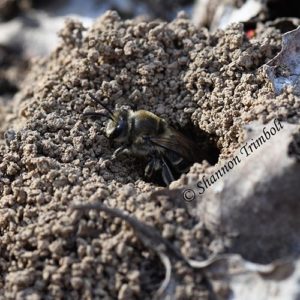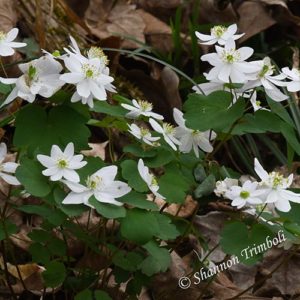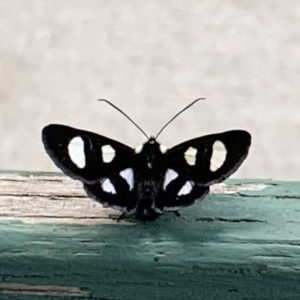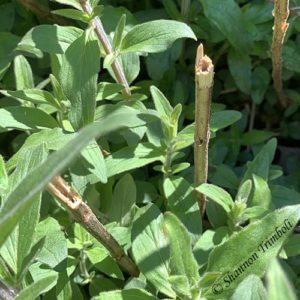This is always such an exciting time of year. The wildflowers are blooming. The insects are appearing again. The birds are starting to sing their dawn chorus in the mornings again. And the spring warbler migration is in full swing. Things are changing almost daily. There is always some new nature-related discovery to be made. Below are a few of my nature-related discoveries and observations over the last few weeks in April.

At the very beginning of the month, I found this little girl in her tunnel! She’s a mining bees and one of our solitary nesting native bees. “Mining bee” is a very general term, kind of like “duck.” I’m not sure which species this one is.
Usually I only find their tunnels; this was the first time I’d seen a bee in one. She was very jumpy and kept scooting back inside if I moved even the tiniest bit. If you want to find them on your property, look in bare spots on your property or areas with sparse vegetation for places that look like an old-fashioned #2 pencil has been jabbed in the ground. Sometimes, like in this picture, they will have the dirt crumbles piled around the entrance like an ant mound, other times you’ll just have the hole.

Each species of mining bee is typically only active above ground for a few weeks each year. Now, less than a full month later, I can’t find any above ground sign up these bees and would never know they were there if I hadn’t seen them. The young of the mining bee in this picture will spend most of their lives below ground in developmental stages before emerging next spring as an adult.
I haven’t said much about this, but this spring has been really hard for me. I’ve been feeling more than a little overwhelmed. Trying to keep up with everything has meant that I haven’t been able to get out and enjoy the wildflowers and spring migration as much as I wanted to. I’m just grateful that our property has lots of wildlife and plants for me to discover if I get a spare hour to explore. One of the spring ephemeral wildflowers that we have on our property that always makes me smile when I see it is rue anemone. It can be found in open woodlands throughout most of the eastern U.S. This year the rue anemone was putting on a beautiful show on our property.

I was sitting on our porch swing working on a blog article one day and a really cool moth landed on my laptop. I wish I could have gotten a picture of it sitting on my laptop and facing me because the first two pairs of legs each had what looked like pollen baskets full of bright orange pollen. Moths don’t have pollen baskets and don’t collect pollen so I knew they weren’t really pollen baskets, but it was enough to intrigue me. A little internet research told me that this is an 8-spotted forester moth and the “pollen” was tufts of hairs on the legs. Apparently, researchers aren’t sure what the purpose of the orange tufts are. I love learning new things!
At the very, very end of March, I cut back last year’s stems in this patch of hairy mountain mint. Instead of completely removing last year’s stems, I left the lower 12-18 inches of the stems in the ground. (No, I didn’t measure it. I just did a rough eyeball guestimate on each.) The reason I left part of the stems is because mountain mint stems are hollow.

A week or two after cutting back the stems this whole patch of mountain mint was buzzing with little bitty bees. They were the size of what most of us would think of as generic “sweat bee-sized” bees. They kept going in and out of the hollow stems, presumably making their nests inside the stems. They were too fast and too tiny for me to get a picture of them and they disappeared as the weather cooled off again.
After, not quite a month of additional new growth on the mountain mint vegetation, you can barely see last year’s stems. It won’t be long before those stems completely disappear within this year’s vegetation. I’ll leave last year’s stems in place all year long because they hopefully contain developing baby bees that will emerge next year in early April. Like the mining bee that I found at the beginning of the month, these bees will spend most of their lives developing in their nesting “tunnel,” or in this case nesting stem.
So, what interesting nature-related discoveries have you made in your yard and community over the last few weeks? I always enjoy hearing what others are finding too.

Backyard Ecology: Exploring Nature in Your Backyard
Nature isn’t just “out there.” It’s all around us, including right outside our doors. Hi, my name is Shannon Trimboli, and I am the host of Backyard Ecology. I live in southcentral Kentucky and am a wildlife biologist, educator, author, beekeeper, and owner of a nursery specializing in plants for pollinators and wildlife conservation. I invite you to join me as we ignite our curiosity and natural wonder, explore our yards and communities, and improve our local pollinator and wildlife habitat. Learn more or subscribe to my email list at www.backyardecology.net.

Leave a Reply